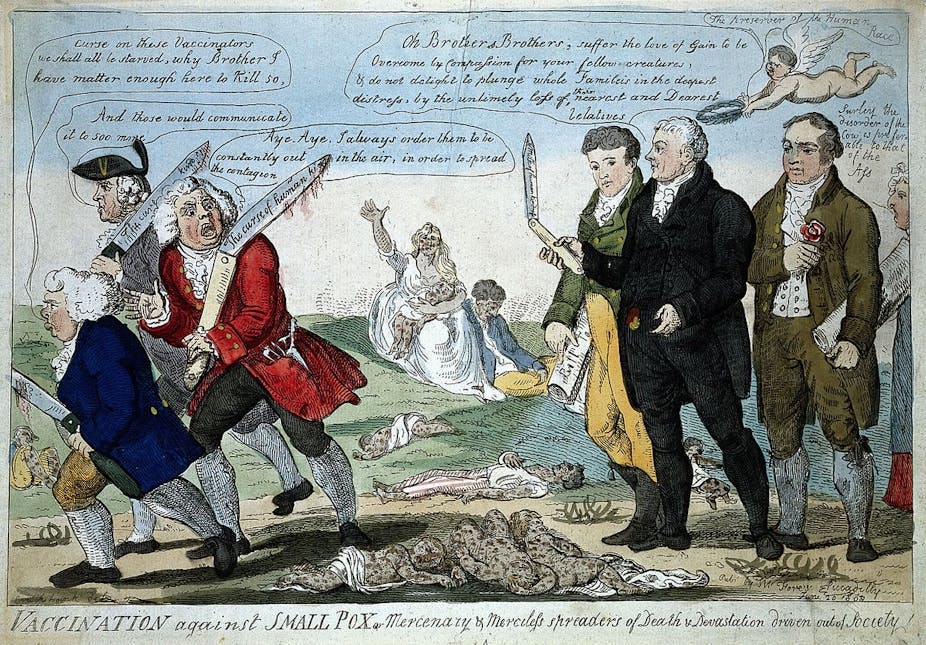When we hear phrases like vaccine objection, vaccine refusal and anti-vaxxers, it’s easy to assume these are new labels used in today’s childhood vaccination debates.
But there’s a long history of opposition to childhood vaccination, from when it was introduced in England in 1796 to protect against smallpox. And many of the themes played out more than 200 years ago still resonate today.
For instance, whether childhood vaccination should be compulsory, or whether there should be penalties for not vaccinating, was debated then as it is now.
Throughout the 19th century, anti-vaxxers widely opposed Britain’s compulsory vaccination laws, leading to their effective end in 1907, when it became much easier to be a conscientious objector. Today, the focus in Australia has turned to ‘no jab, no pay’ or ’no jab, no play’, policies linking childhood vaccination to welfare payments or childcare attendance.
Of course, the methods vaccine objectors use to discuss their position has changed. Today, people share their views on social media, blogs and websites; then, they wrote letters to newspapers for publication, the focus of my research.
Many studies have looked at the role of organised anti-vaccination societies in shaping the vaccination debate. However, “letters to the editor” let us look beyond the inner workings of these societies to show what ordinary people thought about vaccination.
Many of the UK’s larger metropolitan newspapers were wary of publishing letters opposing vaccination, especially those criticising the laws. However, regional newspapers would often publish them.
As part of my research, I looked at more than 1,100 letters to the editor, published in 30 newspapers from south-west England. Here are some of the recurring themes.
Smallpox vaccination a gruesome affair
In 19th century Britain, the only vaccine widely available to the public was against smallpox. Vaccination involved making a series of deep cuts to the arm of the child into which the doctor would insert matter from the wound of a previously vaccinated child.
These open wounds left many children vulnerable to infections, blood poisoning and gangrene. Parents and anti-vaccination campaigners alike described the gruesome scenes that often accompanied the procedure, like this example from the Royal Cornwall Gazette from December 1886:
Some of these poor infants have been borne of pillows for weeks, decaying alive before death ended their sufferings.
Conspiracy theories and vaccine cults
Side-effects were so widespread many parents refused to vaccinate their children. And letters to the editor show they became convinced the medical establishment and the government were aware of the dangers of vaccination.
If this was the case, why was vaccination compulsory? The answer, for many, could be found in a conspiracy theory.
Their letters argued doctors had conned the government into enforcing compulsory vaccination so they could reap the financial benefits. After all, public vaccinators were paid a fee for each child they vaccinated. So people believed compulsory vaccination must have been introduced to maximise doctors’ profits, as this example from the Wiltshire Times in February 1894 shows:
What are the benefits of vaccination? Salaries and bonuses to public vaccinators; these are the benefits; while the individuals who have to endure the operation also have to endure the evils which result from it. Health shattered, lives crippled or destroyed - are these benefits?
Conspiracy theories went further. If doctors knew vaccination could result in infections, then they knew children died from the procedure. As a result, some conspiracy theorists began to argue there was something inherently evil about vaccination. Some saw vaccination as “the mark of the beast”, a ritual perpetuated by a “vaccine cult”. Writing in the Salisbury Times, in December 1903, one critic said:
This is but the prototype of that modern species of doctorcraft, which would have us believe that their highly remunerative invocations of the vaccine god alone avert the utter extermination of the human race by small-pox.
Of course, this is an extreme view. But issues of morality and religion still permeate the anti-vaccination movement today.
Individual rights
For many, the issue of compulsory vaccination was directly related to the rights of the individual. Just like modern anti-vaccination arguments, many people in the 19th century believed compulsory vaccination laws were an incursion into the rights enjoyed by free citizens.
By submitting to the compulsory vaccination laws, a parent was allowing the government to insert itself into the individual home, and take control of a child’s body, something traditionally protected by the parent. Here’s an example from the Royal Cornwall Gazette in April 1899:
[…] civil and religious liberty must of necessity include the right to protect healthy children from calf-lymph defilement […] trust […] cannot be handed over at the demand of a medical tradesunion, or tamely relinquished at the cool request of some reverend rural justice of the peace.
What can we learn by looking at the past?
If anti-vaccination arguments from the past significantly overlap with those presented by their counterparts today, then we can learn about how to deal with anti-vaccination movements in the future.
Not only can we see compulsory vaccination laws in Australia could, as some researchers say, be problematic, we can use the history of vaccine opposition to better understand why vaccination remains so controversial for some people.

